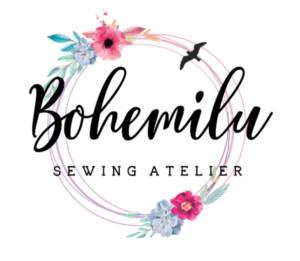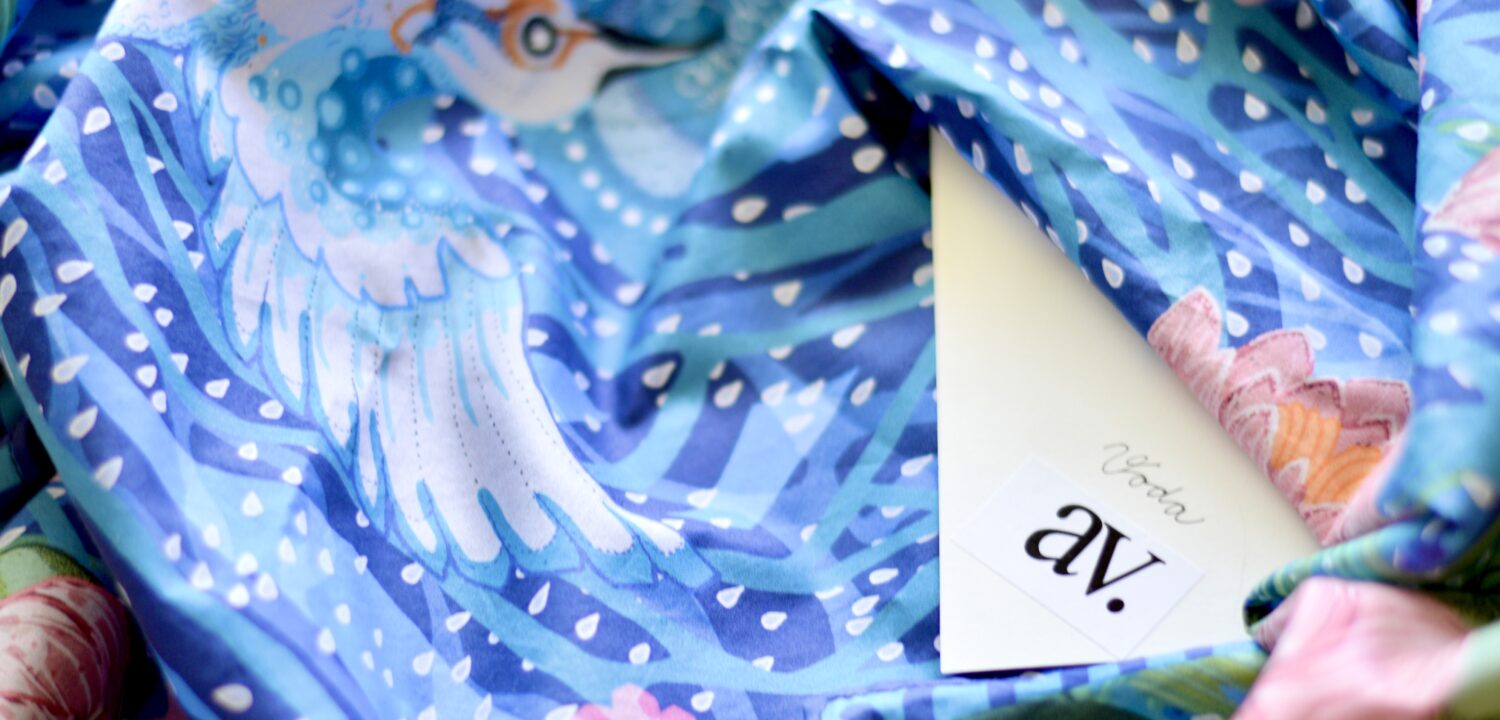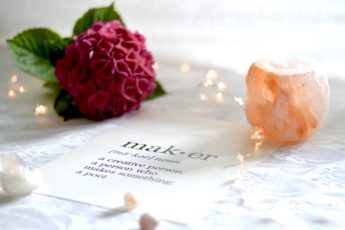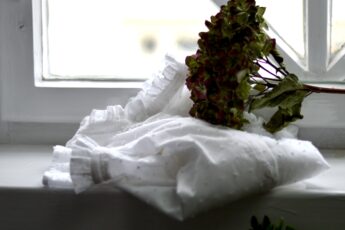I noticed Andrea Vytlacilova, the rising star of the Czech fashion design scene, for the first time this winter when I accidentally came across an article ranking the 30 most successful Czechs under the age of 30. Her enthusiasm for garment creation impressed me immediately as well as the fact she’s the only Czech student at the prestigious Central Saint Martins in London – one of the most reputable fashion design universities in the world. During the lockdown I had the opportunity to do an interview with Andrea about fashion design and her studies where she shares her experience from the real world of fashion design. Enjoy reading and thank you Andrea!
Andrea, the coronavirus lockdown reached you during the time you were supposed to work on your final BA collection. Then you were forced to go back to the Czech Republic and finish the work at home. How did you manage this?
Everything in my collection is about the local production and more specifically, my collection is about returning home. So, despite the circumstances it made perfect sense for me to work on it from home. Obviously at home I do not have access to the ateliers and consequently some creative methods, like sophisticated 3D prints, were not really possible for me. However, I still had some other possibilities I could benefit from.
What are the ways of remote virtual presentation of the final collection? How does it work?
Because of the coronavirus, all physical presentations were cancelled, our graduation was unfortunately cancelled as well. Therefore, the final fashion catwalk was fully virtual, in the form of short videos featuring our final BA collections. The University prepared a kind of virtual reality in order for students to do so. It was totally new, everything happened for the first time this year. From some perspective, it was actually great, as everything was completely fresh and new. The final fashion show was also attended by a range of different sponsors who actually tried to shift themselves more to the digital world, so even for them it was a challenge.
Could you describe what it is like to study at Central Saint Martins? After all, London can be quite difficult place to live in…
The first two years of my studies I stayed at the university’s student residence. But frankly speaking, the place really doesn’t matter, as the first two years of studies meant spending all my time in ateliers. This study program is truly demanding, I really had no free time to do anything else but studying.
How does a typical day for a fashion student at Central Saint Martin fashion student look like?
Well, academic lectures and seminars work quite similarly to what we know from “traditional“ university education. But still, at CSM the professors really insisted on students not to perceive academic knowledge only via the viewpoint of fashion, but they really encouraged us to consider the problematic from the point of view of art in its whole complexity – often via applied art or product. We were learning things thematically rather than according to some time axis. Then in practice, there is a theme given and related working methods as well. Consequently, some technical lessons like practical sewing of pattern drafting follow. And at the final stage you work in the atelier on your garment or collection – it is a practical application of theorical and technical knowledge we students learnt. But really, every week is different the same way every project is different.
How come that currently you are the only person from the Czech Republic who succeeded to get into Central Saint Martins?
I would probably say there are still only few people who even consider to apply there. And let’s be honest – in the Czech Republic the art field were not seen as the most prospective for the future career, they were often stigmatised like something not practical for real life. But nowadays people start waking up and realising that actually, they can do it, that it’s possible to make art for a living and that this possibility is opened up abroad as well. Moreover, the problem is that in the Czech Republic the textile segment itself practically doesn’t exist anymore whereas abroad we are used to having famous fashion houses employing a whole range of specialists having a comfortable lifestyle from the salaries they earn there. Here in the Czech Republic it‘s more likely the designer himself who employs employing a pattern cutter, a sewer… the Czech fashion houses were the domain of the beginning of the century…
I know your background was not always artistic, actually you graduated from a traditional high school in the city in Eastern Bohemia. Was fashion always your dream?
Yeah, it pretty much always was! But as I left the Czech Republic right after my high school graduation, I was kind of surprised when I realized that so many of my schoolmates here in London didn’t know how to draw properly. They didn’t have the same level of preparation as I had at Czech school. The artistic expression is one thing, but without having a solid foundation, there is not too much space for you to work with. I’m kind of obsessed with drawing and frankly, I was practically the only one among my classmates who used to draw so much. It really surprised me. I know some designers can live without drawing but for me it’s hard to understand.
How about the entrance exams to CSM? There were no tests proving candidates’ drawing skills?
Well, it is not based on one unique quality a successful candidate needs to demonstrate, it is rather about the complex impression you make to the committee. For this reason, the entrance exam is divided into several rounds – first it is filling up the application form, then an essay, references from your professors… In the Czech Republic we are used to having a special exam testing your talent, whereas at CSM you present directly your finished projects which are examined by a committee.
So drawing seems to be a very essential skill…
From my point of view, when someone makes a design, at least some basic drawing skill is necessary. You must express an idea through a drawing. If this is impossible, you just cannot present your idea properly to someone else. Not everything can be translated into words. When working in a real fashion house, you make part of a production chain, your sketch goes from one person to another and you can’t be everywhere in order for you to explain your ideas to every single person.
So before entering to CSM, you had a good level of preparation, didn’t you?
Yes, I started when I was five – I attended the lessons in kids art school practically until my departure to London. I got a great teacher there who really supported my dedication to garment. I got a really fair opportunity to interpret various creative assignments through the means of textile and garment, so I could basically test a large number of art techniques while still having the classical drawing preparation like portraits, still lifes… And it was something I could benefit from in particular when I came to London for my studies.
How many years does the BA fashion programme take?
As far as the UK is concerned, there is one mandatory foundation year before you can start your BA program. Foundation is usually about Art and Design in general, you choose your specialisation afterwards. I knew from the very beginning that fashion and textile was what I wanted to do, but this foundation year was extremely beneficial for me in terms of having the possibility to try so many things you could do within your specialisation. Then you have to apply again to the BA programme. Also, it would have been a massive change for me without attending the foundation because of the fact that I came from a traditional high school background. I wouldn’t have been able to direct myself properly and benefit from the study programme fully. After completing two years of the BA programme, there is a possibility of a so-called “placement year” – which means that you could apply for various traineeships worldwide in order to get some practical experience from the industry. Then you finish your third and final BA year. So, in total for me it was 5 years but I have no regrets because a placement year was one of the reasons I applied for CSM.
Was studying abroad something which always attracted you?
Yes, I love English and moreover, CSM offers the study program aimed at what I exactly wished to do – garment and textile design together. Here in the Czech Republic you can’t study both together, but I always wanted it, because I enjoy drawing and therefore the visual aspect is something very close to me. I don’t want to work merely with the things existing already, I want to create my own creations, from the very beginning – from the fabric to the final garment. In addition, this enriches my professional horizon. I was able to put everything in practice during my traineeships in fashion houses in Paris (Kenzo), New York (Marc Jacobs) and Stockholm (Acne Studios). Not only did I work on design development, but I also participated in print. This is another great advantage of studying at CSM – university really insists on the thorough preparation of students for the real industry. Even within our studies we collaborate with established brands on various projects. On top of that, CSM is supported by Moët Hennessy-Louis Vuitton (LVMH) group and this is the reason we have access to the latest technical equipment launched on the market. For example, during my traineeship, I had the experience during which a fashion house ordered a new modern machine I was familiar with already from our university ateliers. This was another benefit for my employers as my initial training didn’t take so much time.
Was there any unexpected challenge you met during the studies? Something which was a real surprise for you?
Ah yes, almost all the time actually! But I think that’s it – to not get unstable. When I came to London I was like Alice in Wonderland, for the first time in my life in the big city, abroad, but with time you get used to constant change and dynamics step by step. Nothing is like what it seems, everything is up in the air. You must adapt yourself and live with the fact that you might be asked to submit a project with a deadline the next day, despite not having any idea where to start…
Now, when you have already experienced work alongside reputable designers, has it actually frightened you off? As it might be quite challenging…
Well, obviously I am very well aware that this is an extremely time consuming profession and there is an immense pressure in fashion houses to always enhance the brand and make it better. Simply, you have to love fashion. If you really want to do fashion design internationally, you have to accept to almost not having time for a private life. It is not unusual to spend almost 24 hours in ateliers, some traineeship are even not paid at all. I lived 6 months in Stockholm working at Acne Studios without being paid – it was really challenging… But I learnt so much there!
What are your future plans?
At the moment, I’m waiting to see how the situation will evolve. But still, I think I would like to spend some more time abroad. And surely I would like to pursue my own design creation.
Actually, you are already pursuing your own creation, at least through the designing the scarf collections which are on sale on your website… 🙂
It is always funny how often people ask me why I create scarves and not garments 🙂 But the thing is that being a student I do not have enough capital for commercial production at the moment. But I would love to restart the textile industry in my country. I am from East Bohemia, a part of the country which was always very known for its strong textile production. In the past everybody associated East Bohemia to textile, as every bigger city used to run a textile factory. Some of them began to restart their operations, with new owners come new investors and the situation is slightly starting to change. Either we will be able to resume the textile production locally or we will be obliged to import everything from China. And I don’t what to witness this, I wish we would continue our well established tradition, I wish we were proud of products made locally. Exactly the same way how this works in England – everybody knows that the textile is a tradition and proudly relates to it.
*****
You can learn more about Andrea’s work on her website www.andreavytlacilova.com . The photo introducing this blog post features Andrea’s collection of scarves called “Voda” which means Water.






Leave a Comment